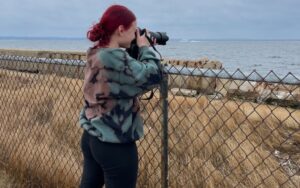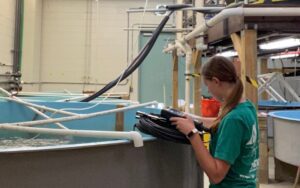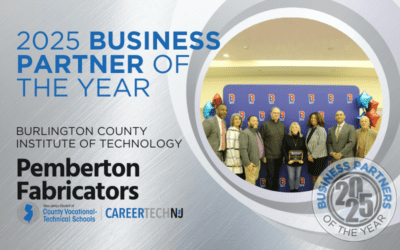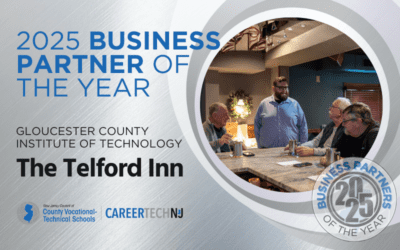
Katie Ackerman, a recent graduate of the Marine Academy of Science and Technology (MAST), part of Monmouth County Vocational School District, takes photos of harbor seals for a project that identifies the seals through facial recognition technology and tracks them.
During her junior year of high school, Katie Ackerman sometimes ran out of class to snap a few photos of seals on the nearby Sandy Hook beaches. She knew they only came to shore at low tide and sought images of them for research. Her classmate, Abby Hesterhagen, caught tautog, also known as blackfish, on a 65-foot “Blue Sea” research vessel and studied them in a National Oceanic and Atmospheric Administration laboratory.
Both students took advantage of the unique learning environment fostered by the Marine Academy of Science and Technology, part of the Monmouth County Vocational School District. Blending the classroom with the real world is standard across New Jersey’s county vocational-technical schools, to support students’ focused learning in a field of study. As students progress through their curriculum, they begin to put all the pieces together to tackle advanced projects, often called capstone projects, as upperclassmen.
These projects test students’ understanding and passion for a subject matter, often leading them toward a career choice within a field and greater awareness of how they can make meaningful contributions through their work.
Ackerman, a 2024 graduate of MAST, spent two years photographing hundreds of harbor seals in Sandy Hook for a population assessment project. She worked with her NOAA mentor, Jeff Pessutti, a physical science technician, to update code for a Python program used for facial recognition. Then, she began loading the photos into the program to identify and track the seals.
“Seals are an indicator species, so, if we identify changes in them, we may know earlier that something is wrong, perhaps in the water,” Ackerman explained.
The project will continue, with MAST students working closely with Pessutti and using NJEA Sustainable Schools grant funding to install a webcam for taking photos, spreading awareness of the project to encourage others to take photos up the coast and creating a website for sharing those photos.
Hesterhagen, also a 2024 graduate of MAST, set out to study the optimal temperature conditions for the early life stage of tautog. She hoped her findings would lead to additional research to determine ideal conditions for saltwater aquaculture fish — the breeding, raising and harvesting of the fish. She said that, in some places, tautog are overfished, so aquaculture could present a resource-efficient solution that results in more fish for consumption in a more economical way.

Abby Hesterhagen conducts research on tautog, or blackfish, in a National Oceanic and Atmospheric Administration (NOAA) Laboratory, which she had access to as a student of the Marine Academy of Science and Technology (MAST), part of Monmouth County Vocational School District.
Although she has graduated, Hesterhagen anticipates other students working with her NOAA mentor, Chris Chambers, a research fishery biologist. The next phase would use new larvae to replicate some of the original studies and set new objectives.
“This has definitely reinforced my decision to become a marine scientist and given me an idea of what a job would be like in the field,” said Hesterhagen. “I also had my pick of acceptances, getting into competitive research and honors programs, because of my project at MAST.”
Hesterhagen will attend the Florida Institute of Technology in the fall, majoring in both marine biology and psychology. Ackerman will attend the University of Miami, majoring in marine biology and ecology.
Engineering solutions for underwater ultrasonic sound
At another county vocational-technical school located by the coast, four Atlantic County Institute of Technology students also tackled research involving marine life. Deemed “the moth girls,” the students learned in their junior year Principles of Sustainability course about biomimicry — the idea that we can emulate nature’s forms, processes and ecosystems to create more sustainable designs. That sparked the idea to take what they know about the scales of the Cabbage Tree Emperor Moth, which absorb up to 50% of ultrasonic sound, to address the emerging issue of new green energy, like offshore wind structures, disturbing marine life through increased ultrasonic sound.
“The moth girls” — Leana Amezquita, Emma Feehan, Ashlee Morales and Hannah Usyk — recently graduated from ACIT’s four-year, engineering-based Academy of Math, Engineering & Science program. They began what they called their “sonar eclipse” project as juniors and then continued it throughout senior year. Taking their knowledge about the scales, they printed and tested 3D panels to create a net-like structure that could be put around construction projects or wind turbines in the ocean. They also examined a range of materials and weighed cost against effectiveness.
“The exposure to the research process for our students is invaluable,” said Brian Vernachio, supervisor of sciences for ACIT. “The students must evaluate resources, link data to present a solution or argument and be flexible throughout each step. Those are important skills, not just for college, but for life, because they develop into critical thinkers.”

“The moth girls” recently graduated from Atlantic County Institute of Technology’s four-year, engineering-based AMES program. Over their junior and senior years, they pursued a “sonar eclipse” project, applying their knowledge about the scales of a moth to design a net-like structure that could be put around construction projects or wind turbines in the ocean to absorb ultrasonic sound.
Vernachio said some student projects end up being patentable. He said the scale-like net designed by “the moth girls” could be one of those projects. After the students presented their concept at the New Jersey School Boards Association’s 2024 STEAM Tank Challenge, they received some resources to start the patent process, as well as potentially receive a nondisclosure agreement for their intellectual property.
The group members are each heading to different institutions in the fall, but they said they look forward to settling in and evaluating available resources to take their idea from “project development stage” to a product.
They collectively agreed, “We have an appreciation for marine life, because we grew up around the Shore. We care a lot about our marine life and want to support our local ecosystem.”
They now move on to college and then into their careers with a solid foundation of knowledge and skills accumulated through their county vocational-technical school education to help them do just that.
Conversation Starter
This series on education and industry is presented by the New Jersey Council of County Vocational-Technical Schools.
Read the original column from June 26, 2024 in ROI-NJ.



